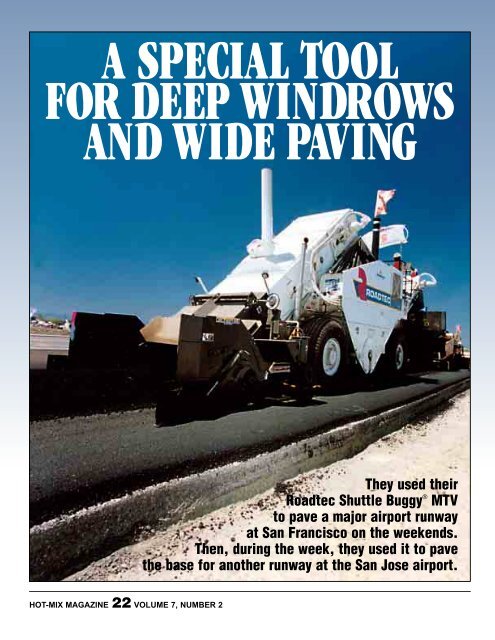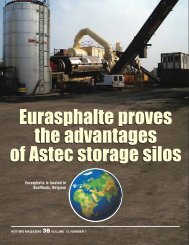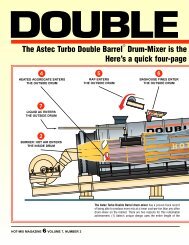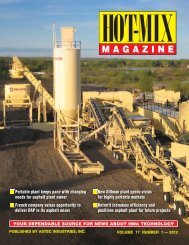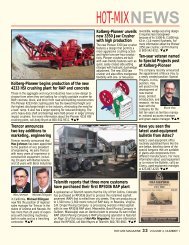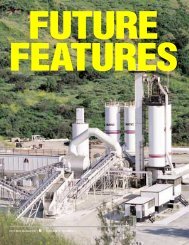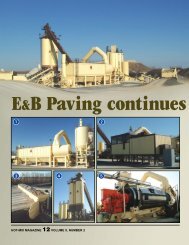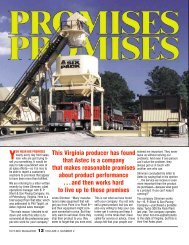Deep Windrow, Wide Paving - Hot-Mix Magazine
Deep Windrow, Wide Paving - Hot-Mix Magazine
Deep Windrow, Wide Paving - Hot-Mix Magazine
Create successful ePaper yourself
Turn your PDF publications into a flip-book with our unique Google optimized e-Paper software.
A SPECIAL TOOL<br />
FOR DEEP WINDROWS<br />
AND WIDE PAVING<br />
They used their<br />
Roadtec Shuttle Buggy ® MTV<br />
to pave a major airport runway<br />
at San Francisco on the weekends.<br />
Then, during the week, they used it to pave<br />
the base for another runway at the San Jose airport.<br />
HOT-MIX MAGAZINE 22 VOLUME 7, NUMBER 2
MEETING A TIGHT DEADLINE<br />
can be a challenge in itself.<br />
But imagine tackling two<br />
different airport paving jobs at the<br />
same time. Both of them involve<br />
extremely strict FAA specifications,<br />
of course. And now picture using<br />
the same piece of equipment on<br />
both jobs—even though the jobs<br />
are about 34 miles (55 km) apart.<br />
Suddenly that challenge becomes<br />
a little tougher, doesn’t it?<br />
But working on tight schedules<br />
under tough specifications can be<br />
quite a bit easier if you utilize the<br />
right tools. That was a key point<br />
for management to consider when<br />
the Pavex Construction Division of<br />
Graniterock contracted to pave two<br />
runways within the same time<br />
period: one at Norman Y. Mineta<br />
San Jose International Airport and<br />
the other at the San Francisco<br />
International Airport. The special<br />
tool they picked so they could move<br />
quickly on both jobs was a Roadtec<br />
SB-2500B Shuttle Buggy ® material<br />
transfer vehicle (MTV).<br />
“The Shuttle Buggy MTV enabled<br />
us to complete the jobs on time,”<br />
said Ray Woolery, the northern<br />
area superintendent for Pavex<br />
Construction located in Redwood<br />
City, California.<br />
On past jobs, Woolery explained,<br />
Pavex Construction had not used<br />
a Shuttle Buggy MTV. Instead,<br />
they used pickup machines to get<br />
hot-mix asphalt (HMA) from the<br />
windrows to the paver. But the<br />
requirements for paving an airport<br />
runway created special conditions<br />
that made the Shuttle Buggy MTV<br />
both desirable and necessary.<br />
“When paving the San Francisco<br />
and San Jose airports’ runways,<br />
we were dealing with very wide<br />
paving—in order to reduce the<br />
number of joints—and varying<br />
depths,” said Woolery. “That’s<br />
where Roadtec’s Shuttle Buggy<br />
MTV came in. You couldn’t do that<br />
kind of work with a regular pickup<br />
machine, because the windrows<br />
would have to be too big in order<br />
to supply the paver with enough<br />
mix to meet the width requirements.<br />
Really, the Shuttle Buggy<br />
MTV is the only machine on earth<br />
that I know of that could do<br />
something like this.”<br />
“You couldn’t do that kind of work<br />
with a regular pickup machine<br />
...The Shuttle Buggy MTV<br />
is the only machine on earth<br />
that I know of that could do<br />
something like this.”<br />
“We ran that thing almost nonstop for five weeks,” said Ray Woolery, northern<br />
area superintendent for Pavex Construction. “There were no major problems.<br />
Just routine maintenance—such as making sure the chains were tight and<br />
cleaning the machine. The biggest thing was making sure it was clean.”<br />
At the San Francisco airport,<br />
Pavex Construction resurfaced the<br />
10,800-ft. (3,292-m) main runway<br />
with 3 to 9 in. (8 to 23 cm) of<br />
HMA. For the San Jose project,<br />
Pavex Construction laid a 2-in.<br />
(5-cm) lift of HMA on Runway 30<br />
Left that will serve as a base for a<br />
16-in. (41-cm) layer of concrete.<br />
The sheer volume of material on<br />
the two projects—about 98,000<br />
tons (88,902 tonnes) of HMA at<br />
San Francisco and 55,000 tons<br />
(49,894 tonnes) at San Jose—<br />
called for the company to do a lot<br />
of paving in a relatively short<br />
amount of time. To expedite the<br />
two jobs, Pavex Construction<br />
came up with a demanding work<br />
schedule for the crews.<br />
“We did San Francisco 24-hours<br />
a day on weekends, from 10 PM<br />
on Friday until 7 AM on Monday.<br />
We would only stop for fuel and<br />
grease,” said Woolery. “Then, on<br />
Monday mornings, we’d move the<br />
Shuttle Buggy MTV the 34 miles<br />
(55 km) to San Jose and pave the<br />
runway there from Tuesday<br />
through Friday.”<br />
The virtually non-stop paving<br />
schedule that Pavex Construction<br />
tackled was another reason the<br />
Roadtec Shuttle Buggy MTV<br />
became a logical imperative for<br />
these projects. Here’s how it<br />
would usually work:<br />
The Shuttle Buggy MTV would<br />
move to an open space near the<br />
paving site where the HMA had<br />
been heavily windrowed from a<br />
bottom-dump vehicle. Using the<br />
SB-2500B MTV’s optional windrow<br />
pickup head, the operator would<br />
FOR MORE INFORMATION<br />
call your Roadtec Regional Sales Manager or call Wendy Porto:<br />
800-272-7100<br />
Fax: 423-265-7521<br />
E-mail: sales@roadtec.com<br />
gather the mix and return to the<br />
runway to supply the mix to the<br />
paver—which never had to stop<br />
working.<br />
The use of the Shuttle Buggy<br />
MTV not only allowed Pavex<br />
Construction to pave unusually<br />
wide areas non-stop. It also<br />
allowed the company to meet its<br />
own high quality standards.<br />
“We strive for quality work, no<br />
matter what equipment we’re<br />
using,” said Woolery. “But with<br />
the Roadtec Shuttle Buggy MTV,<br />
we found improvements in the<br />
quality of mat that would be hard<br />
to achieve without it.”<br />
Woolery went on to list some of<br />
the ways the Shuttle Buggy MTV<br />
improved the quality of paving:<br />
❏ Better compaction: “We used<br />
pickup machines on the shoulders<br />
of the runway at the San Francisco<br />
airport while the Shuttle Buggy<br />
MTV did the mainline part of the<br />
runway,” said Woolery. “And the<br />
compaction density was about 2-<br />
to 3-percent higher with the<br />
paving that was done using the<br />
Shuttle Buggy MTV.”<br />
❏ Better quality mix: “There was<br />
a big difference in the quality of<br />
mix coming out of the paver that<br />
was using the Shuttle Buggy MTV,”<br />
said Woolery. “When the material<br />
is dropped into the Shuttle Buggy<br />
MTV’s hopper, it goes directly onto<br />
the chain. None of it is dropped<br />
into corners where the material<br />
could segregate. And then, the<br />
Shuttle Buggy MTV re-mixes the<br />
material as it feeds it into the paver’s<br />
hopper. Those are all advantages.<br />
Plus, the heat in the mat is much<br />
more even because the paver just<br />
keeps moving.”<br />
❏ Better longitudinal joints:<br />
“Before, when we paved without<br />
the Shuttle Buggy MTV, you could<br />
easily find where the joints were,<br />
even though we worked hard to<br />
make them smooth,” Woolery said.<br />
“But with the Shuttle Buggy MTV,<br />
we can make the job so smooth<br />
that it is very difficult to find the<br />
joints. The inspectors like to take<br />
core samples from the joints, but<br />
on this particular job, they were<br />
perplexed because they just<br />
couldn’t find them!” ▼▲▼<br />
HOT-MIX MAGAZINE 23 VOLUME 7, NUMBER 2


